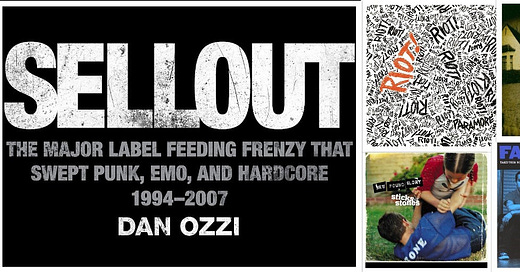Review: "Sellout: The Major Label Feeding Frenzy..." leaves behind crucial stories
Missing bands within the period leave nothing more than a PowerPoint presentation of certain bands, not a full picture of the era
Full of record label history of its time, Dan Ozzi’s book Sellout: The Major Label Feeding Frenzy That Swept Emo, Punk, and Hardcore (1994-2007) caught my eye when a friend mentioned it to me. Growing up in a suburban sprawl during this music era certainly formed who I am today. Marketed toward the Invader Zim-period Hot Topic demographic with terribly catchy choruses and a constant adolescence agenda, emo was sadly integral to my development. Although I feel like I have nothing but scorn and revulsion toward this music today, I cannot deny I read Sellout with a childish glee remembering each album or song mentioned.
The heart of the book is full with passionate chronicles of the bands the author chose to focus upon. Dan Ozzi lovingly covers some of the best of the best. Thursday, Jimmy Eat World, Blink-182, At The Drive-In, The Distillers, Against Me! Despite my own personal opinions of these bands, I sped through each chapter eager to learn, relive, or become sentimental for a time when TRL dictated a band’s trajectory.
For all its research and care, Sellout doesn’t move beyond these nostalgic motions. Without my own experience and knowledge to draw from, it couldn’t hold a candle to a definitive take of the time.
The conceit is whether a band became successful with or without major label interference. Some bands were headed toward success either way (Green Day, Blink) and some were meant for the underground permanently (Thursday, Against Me!). Missing are the counterpoints for a remarkable book of music criticism: context, analysis, and a punishing eye for taste — one cannot understand why The Donnas or Rise Against have their own sections. On top of these crucial elements, the book fails to mention three fundamental bands within the genre, history, and umbrella of awkward, talentless and inexperienced showmanship which fused itself to contemporary music today.
From the back cover the glaring omission of Fall Out Boy, unfortunately one of the most successful bands in the last quarter century, is a cause for confusion. Take This To Your Grave, an independent album distributed through a major label much like Blink-182’s Dude Ranch, was released to pop-punk level acclaim and propelled the band to their breakthrough mainstream success with From Under The Cork Tree. The aforementioned album debuted at number nine on the Billboard charts and eventually went two times platinum status, helping Take This To Your Grave get to gold status. Fall Out Boy continued to reign supreme while on a major, generating breakthrough singles and collaborations with Jay-Z, John Mayer, and Elvis Costello. Considering the high water mark the band created with their success, a passing mention doesn’t do the book any service.
Even Emo’s King of Pain, doesn’t get more than a single reference. Chris Carrabba, once the front-man of unprocessed punk outfit Further Seems Forever, left to take part in MTV Studio singalongs and an ace spot on the Spider-Man 2 Soundtrack underneath the moniker Dashboard Confessional. Granted, this massively profitable supernova remained independent from the majors and still managed to become a megahit in the likes of MTV, Rolling Stone, Entertainment Weekly, and Sony Pictures. Their album A Mark, A Mission, A Brand, A Scar went gold. In regards to the book, Dashboard’s success seems like a best case scenario. As much as I personally detest Dashboard in my old and decrypt age, I at least acknowledge the tidal waves they made for other bands. The same waves Green Day did a decade earlier.
And as much as I admit my disdain for Dashboard but understand their place in the era, I’d also admit the same about Paramore, a band I genuinely admire and applaud but shake my head at their uneducated business decisions. Any simple Google search or five-minute video on YouTube can explain the near deaths of Paramore due to major label pressure and paperwork nonsense. Ultimately, childish ignorance and damning judgments created a rift when singer Hayley Williams signed a major label contract separate from the band itself. This was all before the release of their critically acclaimed, triple platinum album RIOT! which featured two platinum certified singles. Later, guitarist Josh Farro quit the band and described the Paramore as a “manufactured product of a major label.” Williams was accused of being manipulated by the major label to be a Top 40 solo artist. Paramore’s tremendous rise is a classic rock story with misunderstood consequences thrown at talented teenagers on the cusp of stardom, and yet this story is absent? If anything, it demonstrates the decades old, patriarchal, greedy power of the music industry reaching its grimy hands into the lucrative genre of pop punk and emo. Surely the chapter about jock rock band Rise Against could have been replaced with this monumental, perhaps essential story of the time.
Like I mentioned before, the book lacks the context of these particular bands. I realized too late into the book that despite my elderly age, my memory was filling in the gaps and producing a better book. I am aware of the day and age of Fall Out Boy music video premieres, New Found Glory tour announcements, and AbsolutePunk weekly charts. For a newcomer or someone interested in an informative history of the once-dominant genre, Sellout has a lot missing. Although, on the other hand, given my own apathy for the time, perhaps it’s best to leave some things behind.


